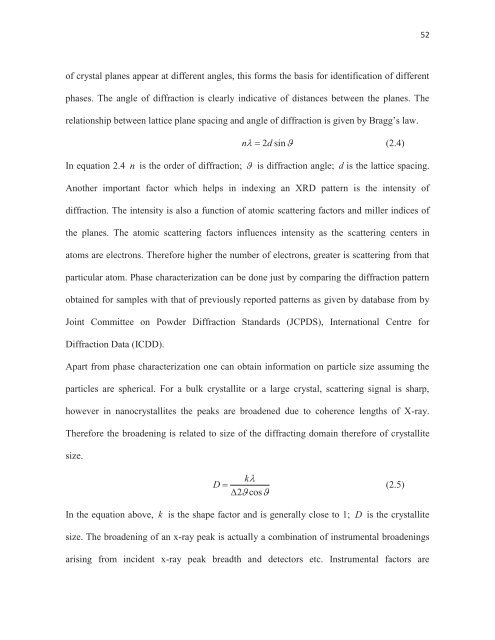CHEM01200604009 Sreejith Kaniyankandy - Homi Bhabha ...
CHEM01200604009 Sreejith Kaniyankandy - Homi Bhabha ...
CHEM01200604009 Sreejith Kaniyankandy - Homi Bhabha ...
Create successful ePaper yourself
Turn your PDF publications into a flip-book with our unique Google optimized e-Paper software.
52<br />
of crystal planes appear at different angles, this forms the basis for identification of different<br />
phases. The angle of diffraction is clearly indicative of distances between the planes. The<br />
relationship between lattice plane spacing and angle of diffraction is given by Bragg’s law.<br />
n<br />
2dsin<br />
(2.4)<br />
In equation 2.4 n is the order of diffraction; is diffraction angle; d is the lattice spacing.<br />
Another important factor which helps in indexing an XRD pattern is the intensity of<br />
diffraction. The intensity is also a function of atomic scattering factors and miller indices of<br />
the planes. The atomic scattering factors influences intensity as the scattering centers in<br />
atoms are electrons. Therefore higher the number of electrons, greater is scattering from that<br />
particular atom. Phase characterization can be done just by comparing the diffraction pattern<br />
obtained for samples with that of previously reported patterns as given by database from by<br />
Joint Committee on Powder Diffraction Standards (JCPDS), International Centre for<br />
Diffraction Data (ICDD).<br />
Apart from phase characterization one can obtain information on particle size assuming the<br />
particles are spherical. For a bulk crystallite or a large crystal, scattering signal is sharp,<br />
however in nanocrystallites the peaks are broadened due to coherence lengths of X-ray.<br />
Therefore the broadening is related to size of the diffracting domain therefore of crystallite<br />
size.<br />
k<br />
D <br />
2cos<br />
(2.5)<br />
In the equation above, k is the shape factor and is generally close to 1; D is the crystallite<br />
size. The broadening of an x-ray peak is actually a combination of instrumental broadenings<br />
arising from incident x-ray peak breadth and detectors etc. Instrumental factors are
















